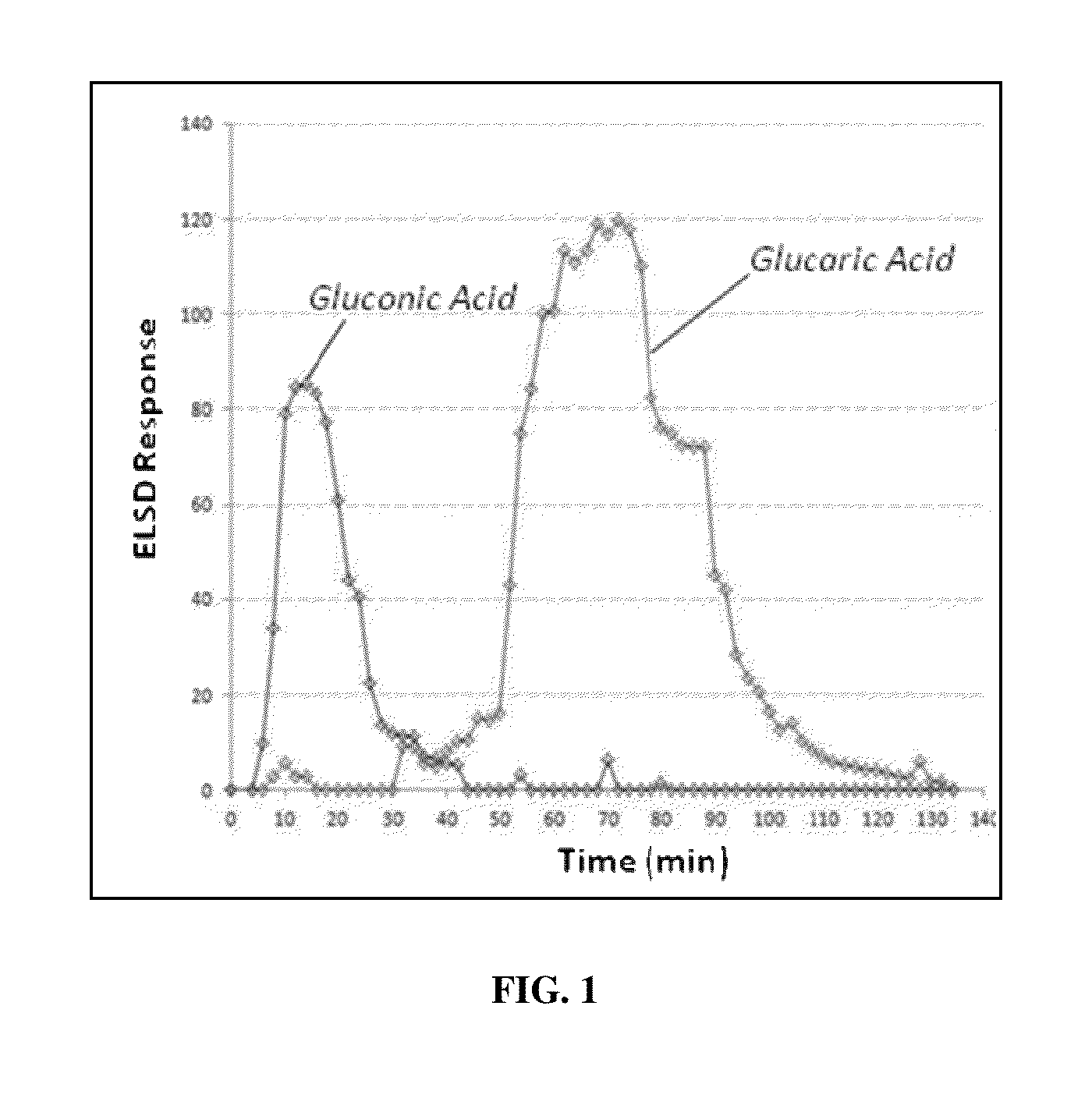Water concentration reduction process
a technology of water concentration reduction and process, applied in the preparation of amino compounds, carboxylic compounds, organic chemistry, etc., can solve the problems of inability to use such methods in industrial production of specialty or industrial chemicals, and each of the known approaches suffers from various limitations
- Summary
- Abstract
- Description
- Claims
- Application Information
AI Technical Summary
Benefits of technology
Problems solved by technology
Method used
Image
Examples
example 1
Effect of Water Concentration on Hydrodeoxygenation of Glucaric Acid to Adipic Acid
[0110]20 mg catalyst (1.7% Pt-0.6% Rh / Davisil 635) was dispensed into a 1.2 mL vial. Glacial acetic acid was added followed by a 10% water / acetic acid solution according to Table 1. 50 μL of an acetic acid solution containing 1.2 M HBr and 1.6 M D-glucaric acid was added bringing the final solution volume to 100 μL. The vials were transferred to a pressure reactor which was then sealed, purged with nitrogen and pressurized with hydrogen to 820 psig at room temperature. The reactor was agitated and heated to 160° C. for 90 minutes. After 90 minutes, the reactor was cooled to room temperature, vented, and purged with nitrogen prior to being unsealed. Adipic acid yields were determined by mass spectrometry relative to a d8-adipic acid internal standard.
TABLE 2Experimental Data for Example 1SolventAcetic10% H2O / CompositionAcidAcetic AcidAceticAdipicExperimentAdditionAdditionAcidWaterAcid YieldNumber(μL)(μ...
example 2
Reduction of Water Concentration During the Separation of Components by Ion-Exchange Chromatography on Commercial Resins
[0112]Aqueous solutions of glucose, gluconic acid, D-glucaric acid, and tartaric acid were injected individually into selected resins using the Gilson preparative LC system. Mobile phase components were water and acetic acid.
[0113]The first seven resins listed in Table 1 were tested with the following method:
[0114]1) flow rates 2-5 mL / min,
[0115]2) gradient elution from 5-95% acetic acid in water,
[0116]3) injections of 1 mL (200 mg / mL solutions), and
[0117]4) fractions were collected and re-analyzed by HPLC and / or ion chromatography.
[0118]The results illustrated that glucose was not retained under any conditions, and gluconic acid (a C6 mono-acid), eluted at lower acetic acid concentrations (5-30% acetic acid), and D-glucaric acid and tartaric acid (an “other C6 di-acid”) eluted at higher acetic acid concentrations (50% acetic acid). These results demonstrate that, i...
example 3
Reduction of Water Concentration During the Separation of Components by Ion-Exchange Chromatography on Select Commercial Resins
[0119]The following resins were selected based on the results in Example 2: Mitsubishi Diaion UBA100S, DOWEX Retardion 11A8, and Mitsubishi Diaion SA21.
[0120]Aqueous solutions of glucose, gluconic acid, D-glucaric acid, and tartaric acid were injected individually into the Gilson preparative LC system. Mobile phase components were water and acetic acid.
[0121]A gradient elution condition was deployed using the following conditions:
[0122]1) flow rate 5 mL / min,
[0123]2) gradient elution from 5-50% acetic acid in water,
[0124]3) injections of 0.25 mL (200 mg / mL solutions), and
[0125]4) fractions were collected and re-analyzed by HPLC and / or ion chromatography. Blank runs were injected prior to and after each sample.
[0126]The order of retention of the components were tartaric acid>glucaric acid>gluconic acid>glucose. The results again illustrated that glucose was no...
PUM
| Property | Measurement | Unit |
|---|---|---|
| length | aaaaa | aaaaa |
| length | aaaaa | aaaaa |
| particle size | aaaaa | aaaaa |
Abstract
Description
Claims
Application Information
 Login to View More
Login to View More - R&D
- Intellectual Property
- Life Sciences
- Materials
- Tech Scout
- Unparalleled Data Quality
- Higher Quality Content
- 60% Fewer Hallucinations
Browse by: Latest US Patents, China's latest patents, Technical Efficacy Thesaurus, Application Domain, Technology Topic, Popular Technical Reports.
© 2025 PatSnap. All rights reserved.Legal|Privacy policy|Modern Slavery Act Transparency Statement|Sitemap|About US| Contact US: help@patsnap.com



